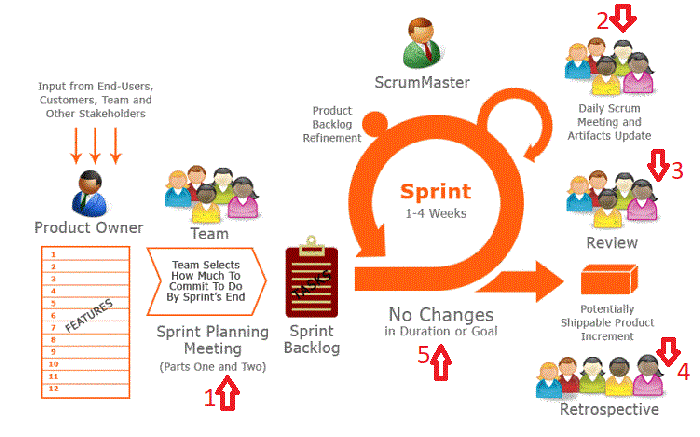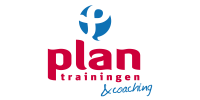 Often we see the ceremonies visualized in a nice loop. Like this.
Often we see the ceremonies visualized in a nice loop. Like this.
Looks great! But what do we actually dó during each ceremony?
Even those who have been working with scrum for a while, sometimes have questions concerning the right order of succession.
Let’s have a closer look:
Each sprint takes off with the Sprint Planning
1. Product Owner (PO) presents the Backlog and the priorities (yes: he did his homework before the sprint starts) to the Development Team (DT)
2. PO and DT debate on these priorities and DT selects a reasonable amount of items to put on their Sprint Backlog for this sprint. They commit to these items to be realised at the end of the sprint.
3. DT makes the Definitions of Done for each item, after questioning the PO.
4. DT breaks down the selected items in tasks and puts these tasks on the scrum bord. (To Do -section)
5. DT makes an accurate estimation of the expected duration of each task. (e.g. planning poker)
6. DT divides the tasks amongst themselves. (volunteering)
Ps. After ending phase 3 the PO may leave. Off course he or she needs to be available at all times for further questions.
Ready set? Gooo
You can start your Sprint.
All Development Team members pick their first tasks from the Scrum Bord‘s “To Do” section and place the post it in the “doing” section.
Each day, halfway the day, the DT gathers round the Scrum Bord for the Daily Stand Up or Daily Scrum.
During this 15 minute ceremony the DT members give an update on their tasks. Still on schedule? Need any help from your colleagues? If any further help or discussion is needed, the members involved continue this discussion after the Stand Up. The rest of the crew can continue with their current tasks. So no long boring meetings. Just a quick daily check. Every day at the same time.
Ps. Even though the tasks are split amongst the team members, the whole team remains responsible for all the tasks on the scrum bord.
At the end of the sprint period (e.g. two weeks) on the last day, we have a check with our stakeholders (e.g. customers and end users) during a presentation. This is called the Review.
- The PO has invited relevant stakeholders to the Review ceremony.
- The PO gives the stakeholders an update on what items are finalized during this sprint.
- The DT shows the items and, if relevant, shares new insights.
- Stakeholders share their thought, feedback and questions.
- PO puts all agreed feedback on the Product Backlog to take up in one of the following sprints.
After this, at the very end of the sprint cycle, the DT has their Retrospective.
They evaluate their way of working.
Honesty is key. The team reflects on several things. Like communication, team effort, expectations, impediments, or whatever comes to mind that is relevant for the output of the team. One or two outcomes are chosen to focus on in the upcoming sprint(s).
My advice is to put these on the Product Backlog or Sprint Backlog. To keep them top of mind.
Don’t forget to PARTY. Cause you’ve done a hell of a job!
Next (mon-)day: next sprint starts. With the exact same steps as all of the above.
Where is the Scrum Master (SM) in all of this?
He or she is there all the time, to guide the process.
The SM trains the DT and PO in their roles; helps them deal with the environment; coaches the team and the individuals; makes sure the ceremonies are done properly and in the right time frame.
The SM doesn’t have to know anything about the work at hand. He or she just needs to be a hell of a team coach, lobbyist and Scrum expert.
His/Her main role is to make sure the team has excellent output.
Living in the Netherlands and need a Scrum trainer or Scrum Master?
In English or Dutch?
Please contact: sandra@plantrainingen.nl
